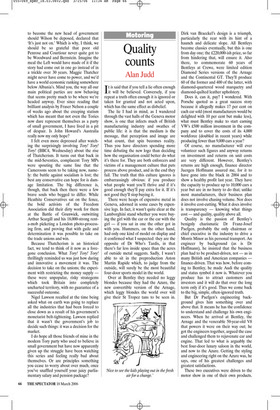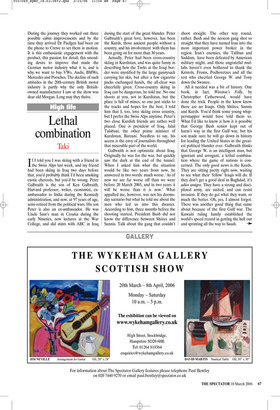Quality counts
Alan Judd
It is said that if you tell a lie often enough it will be believed. Conversely, if you repeat a truth often enough it is ignored or taken for granted and not acted upon, which has the same effect as disbelief.
The lie I had in mind, as I wandered through the vast halls of the Geneva motor show, is one that infects much of British manufacturing industry and swathes of public life: it is that the medium is the message, that perception and image are what count, that spin becomes reality. Thus you have directors spending more time debating the new logo than deciding how the organisation could better do what it’s there for. They are both enforcers and victims of a management culture that puts process above product, and in the end they fail. The truth that this culture ignores is embarrassingly obvious: if you produce what people want you’ll thrive and if it’s good enough they’ll pay extra for it. If it’s not good they’ll stop buying it.
There were heaps of expensive metal in Geneva, adorned in some cases by expensive legs. In fact, it wasn’t quite clear at the Lamborghini stand whether you were buying the girl with the car or the car with the girl — if you sat in one the other got in with you. Hummers, on the other hand, had only one kind of model on display and it confirmed what I suspected: they are the opposite of Dr Who’s Tardis, in that there’s far less inside space than the acres of outside metal suggests. Sadly, I wasn’t able to sit in the preproduction Aston Martin Rapide which, to judge from the outside, will surely be the most beautiful four-door sports model in the world.
Over at Bentley they needed no leggy blondes because they had the Azure, the new convertible version of the Arnage, which leggy blondes the world over will give their St Tropez tans to be seen in. Dirk van Braeckel’s design is a triumph, particularly the rear with its hint of a haunch and delicate slope. All Bentleys become classics eventually, but this is one from day one; the £220,000-ish price, so far from hindering that, will ensure it. Also there, to commemorate 60 years of Bentleys at Crewe, were limited edition Diamond Series versions of the Arnage and the Continental GT. They’ll produce 60 of the former and 400 of the latter, with diamond-quartered wood marquetry and diamond-quilted leather upholstery.
Does it, can it, pay? I wondered. With Porsche quoted as a great success story because it allegedly makes 17 per cent on each car sold (most manufacturers would be delighted with 10 per cent but make less), what must Bentley make to start earning VW’s £500 million investment in the company and to cover the costs of its 4,000 workforce (doubled in recent years) while producing fewer than 9,000 cars a year?
Of course, no manufacturer will ever volunteer such figures and anyway returns on investment and returns on unit costs are very different. However, Bentley’s returns are high enough, finance director Juergen Hoffmann assured me, for it to have gone into the black in 2004 and to show a healthy profit last year. They have the capacity to produce up to 10,000 cars a year but are in no hurry to do that; unlike most manufacturers, their business plan does not involve chasing volume. Nor does it involve cost-cutting. What it does involve is transparency — knowing what things cost — and quality, quality above all.
Quality is the passion of Bentley’s benignly charismatic Dr Franz-Josef Paefgen, probably the only chairman or chief executive in the industry to drive a Morris Minor as his personal transport. An engineer by background (as is Dr Hoffmann), he insisted that the business plan had to be product-driven, not — as in many British and American companies finance-driven. That was how, before coming to Bentley, he made Audi the quality and status symbol it now is. Whatever you produce has to attract customers and investors and it will do that over the long term only if it’s good. Thus we come back to the big, simple, often-ignored truth.
But Dr Paefgen’s engineering background gives him something over and above that. It means he has the confidence to understand and challenge his own engineers. When he arrived at Bentley, the Arnage and the venerable 50-year-old V8 that powers it were on their way out; he got the engineers together, argued the case and challenged them to rejuvenate car and engine. That led to what is arguably the best four-door luxury saloon in the world, and now to the Azure. Getting the styling and engineering right on the Azure was, he says, one of his greatest challenges and greatest satisfactions.
These two executives were driven to the motor show in one of their own products. During the journey they worked out three possible cabin improvements and by the time they arrived Dr Paefgen had been on the phone to Crewe to set them in motion. It is this enthusiastic engagement with the product, this passion for detail, this unending desire to improve that made the German motor industry what it is, and is why we want to buy VWs, Audis, BMWs, Mercedes and Porsches. The decline of such attitudes in the 20th-century British motor industry is partly why the only Britishowned manufacturer I saw at the show was dear old Morgan. Long may they thrive.



















































































 Previous page
Previous page